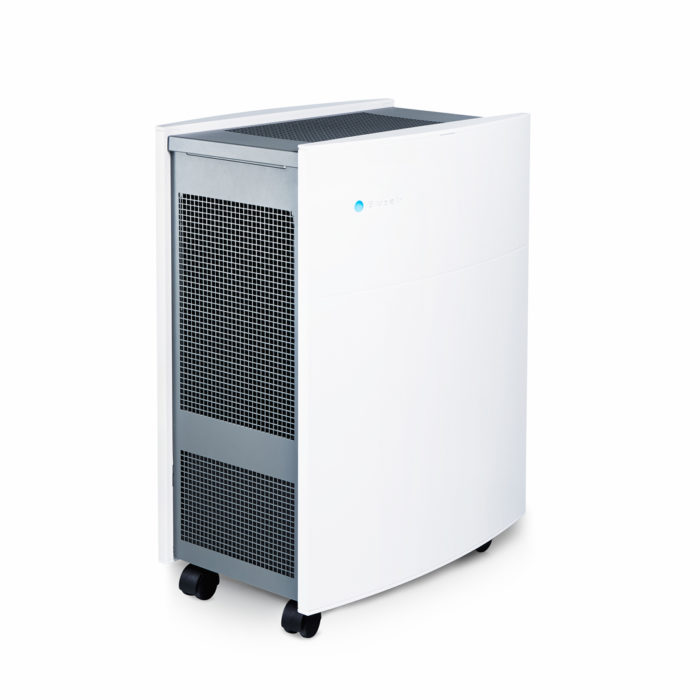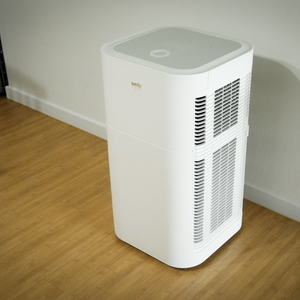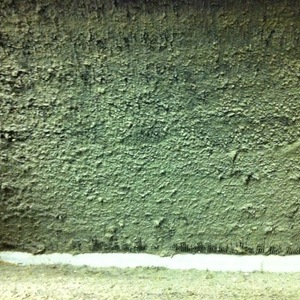
Image Credit: BlueAir
If you’re concerned about indoor air quality, you may have noticed ads for a type of appliance called a portable air purifier. Purchasers hope that these boxes will suck in dirty air and discharge clean air, but few homeowners know how these appliances operate.
In this article, I’ll try to answer a few basic questions about portable air purifiers:
- How many kinds of portable air purifiers are on the market?
- Do they work?
- Who needs one?
Exaggerated claims
If you Google “air purifiers,” you’ll quickly discover retailers who make outlandish claims. Air purifiers are the radiant barriers of the IAQ world. In other words, air purifiers often work, but the field seems to attract a lot of charlatans.
For example, in an online ad, a company called Dyson claims that its appliance “automatically purifies to remove allergens, pollutants and gases from the air.” Well, if the device removes gases from the air, that must mean that the device simply emits particulates — probably by spraying the room with soot. I think I’ll pass. I’d rather have an air purifier that removes the solids from the air and lets the gases pass right through.
Types of air purifiers on the market
Portable air purifiers are devices that sit on the floor of a room. A portable air purifier is designed to clean the air of a single room, not an entire house. Most air purifiers include a fan; the device pulls air into the appliance, does something to the air, and then discharges it. Most models cost between $100 and $1,000.
Most air purifiers include a particulate filter — a filter that in some cases meets the standard for a HEPA (high efficiency particulate air) filter. Other air purifiers claim to clean the air with an activated charcoal filter…
Weekly Newsletter
Get building science and energy efficiency advice, plus special offers, in your inbox.

This article is only available to GBA Prime Members
Sign up for a free trial and get instant access to this article as well as GBA’s complete library of premium articles and construction details.
Start Free TrialAlready a member? Log in















21 Comments
AWESOME article
Thanks Martin, one of your best! The main reason I got into high-performing houses, 20+ years a go, was because of IAQ. This is a very comprehensive and detailed explanation about the "fake" claims made by manufactures of air-purifiers, and becomes a good one-stop-read resource to show our clients the advantages of installing ERVs and HRVs in their homes.
Informative and humorous
This was a fun read. I have breathing allergies so have researched this topic. Agree this article is a very informative good summary. And good humor.
Yes, a good read
Living on the West Coast during the 1980s I was exposed to every imaginable form of purifying filters and burnt offerings. I think I've almost recovered.
Something I didn't see here
Something I didn't see here was if there is any scientific evidence that high performance filters (HEPA and otherwise) in air handlers and ventilators have significant health benefits? Or is it still too mixed up with other factors? I realize it makes good sense, just wondering if there's any hard evidence.
Response to Andy Kosick
Andy,
As far as I know, the amount of evidence showing health benefits from HEPA filters attached to air handlers is the same as the amount of evidence showing health benefits from HEPA filters in portable air purifiers. There is none.
insidious advertising
I, too, appreciated this article. It is clear and useful. And as I scrolled through the comments, a goog*e ad for this popped up:
https://molekule.com/breathe
I clicked - couldn't help myself - I was oh so curious ... and learned that Martin neglected to discuss miracle-molecular air purifiers!
;-)
Response to Rachel Wagner
Rachel,
Thanks for the link! As expected, lots of fancy words, but not much explanation. We learn that "Molekule’s patented technology, Photo Electrochemical Oxidation (PECO), works at the molecular level to eliminate indoor air pollution."
Wow! It works on the molecular level! Just like -- well, fire, evaporation, breathing, or most everyday processes.
Worth clarifying
If it works at the molecular or molekular level.
Proof of long-term health benefits may be too high a bar
There has never been a study of the long-term health benefits of avoiding motor vehicle accidents. We've had plenty of studies on traffic injuries, but no careful studies of the reverse. That's because the study of "long-term health benefits", as Martin's article notes, is very difficult, expensive, and "affected by multiple factors". While it is good to be forewarned that there is no scientific proof that removing particulates from the air provides a long-term health benefit, dismissing every product without such proof is roughly equivalent to dismissing every product.
Can anyone provide a scientific study proving the long-term health benefits from installing a MERV-rated furnace filter? An ERV? An HRV? A range hood? I'm betting that the answer is "no". Yet we recommend all those things. We know the problems that these products address, and we don't demand proof of long-term health benefits from using them, before considering installing them in our homes.
In helping to avoid fraudulent and misleading marketing, let's not apply a product selection "filter" to one product, that we ignore for all the others. There are solid reasons for avoiding most of these air purifier products, without demanding that they clear the bar on proof of long-term health benefits.
Response to Derek Roff
Derek,
Your point is well taken. That said, the health benefits of some environmental factors have been studied, and the results are convincing. People who never smoke cigarettes have much lower rates of lung cancer than people who smoke. Children who grow up in homes with lead paint are at much higher risk of lead poisoning than children who grow up in homes that are free of lead paint. These findings are stark and unambiguous.
While it was taken for granted by two generations of parents that keeping children clean helped keep them healthy, the hygiene hypothesis has turned that assumption on its head. We now know that small children who are exposed to dirt -- and especially children who are exposed to barns and animal manure -- at an early age are healthier than small children who are kept clean. Who knew?
In other words, assumptions can be tricky.
Dyson
Martin - regarding the Dyson unit: a quick look past the slick advertising and the insane price ($500) yields some useful information - the Dyson unit uses a HEPA filter for particles and graphite filters for VOCs...and it uses an efficient DC motor as well.
http://www.dyson.com/air-treatment/purifiers/dyson-pure-cool-link-evo/technology.aspx
Particles
The most recent study of outdoor fine particulate matter (PM2.5) and death rates seems to conclude that there's no "safe" level of outdoor PM2.5.
http://www.nejm.org/doi/full/10.1056/NEJMoa1702747
http://www.nejm.org/do/10.1056/NEJMdo005174/full/?requestType=popUp&relatedArticle=10.1056%2FNEJMoa1702747 (Video summary)
If there's no known safe level of outdoor PM2.5, it's not a big stretch to suppose that there's probably no known safe level of indoor PM2.5, either. In fact, there was a 2016 workshop at the National Academy of Science to "...discuss the state of the science on the health effects of indoor exposure to particulate matter." It looks like many of the indoor air quality bigwigs in North America attended...including Terry Brennan. For those that want to dig into this, all of the presentations and videos are available for viewing here: https://www.youtube.com/watch?v=WxvfTpTwZ4A&list=PLGTMA6QkejfgNEcYW20rxP0lxmtq4CYOX&index=16
Regarding room air "purifiers": at the workshop, presenter Bill Fisk pointed to research that shows that MERV 16 or HEPA level filtration on stand-alone room filtration systems is an effective method for reducing indoor PM2.5, and in a typical home (with a poorly designed HVAC system) could reduce PM2.5 for a fraction of the energy compared to a high-MERV filter inline with the ductwork.
It's a shame that there's so much snake oil in this product market. There are some super effective room filtration products on the marketplace, but end users have to wade through the muck to find them.
Response to John Semmelhack
John,
Thanks for your comments. In my 2016 article, All About Indoor Air Quality, I advised GBA readers:
"Most of the chemicals that show up in the questions posted on GBA don’t make the list [of worrisome substances created by LBNL researchers]. What matters most? It turns out that fine particulates — PM2.5 — cause the most health damage. In fact, these fine particulates are three times more concerning (from a health perspective) than the next most worrisome contaminant on the list. Some of these particulates come from outdoor air, due (for example) to diesel exhaust or wood smoke. The rest come from indoor activities like cooking and burning candles. (For more information on the researchers' findings, see “Hidden Dangers in the Air We Breathe.”)
"If your home has a supply ventilation system (for example, a central-fan-integrated supply ventilation system), it's a good idea to include a MERV 13 filter. This filter should be installed at your air handler or furnace. If your home has a balanced ventilation system (an HRV or ERV), choose a ventilating appliance that offers a MERV 13 option. A MERV 13 filter will eliminate most of the PM2.5 particles entering your home.
"According to Terry Brennan, a building scientist who serves on the ASHRAE 62.2 committee, “The kitchen range is the biggest stationary source of fine particulates in a residential setting. It's the pyrolizing and burning of food that makes most of the particulates and contaminants.” So install a good range hood fan, and use it."
This remains good advice, in my opinion, even in the absence of research that nails down any connection between these MERV 13 (or MERV 16) filters and improvements in occupant health.
I think we can agree as well that (as this article explains), when it comes to a portable air purifier, a smart purchaser only cares about one thing: Is it a HEPA filter?
Finally, I don't doubt that the Dyson air purifier removes particulates from the air. I just wish the company's marketing department knew the difference between solids and gases.
Box fan with filter
There are a lot of DIY-ers here on GBA. For those that want a super low-cost, high MERV room air filter for just a handful of bucks, the box fan filter "hack" is the way to go. $20 fan, ~$15-$30 2-in to 4-in MERV 13 filter, and a little tape. The woodworkers among the crowd will build a fancy-looking enclosure for it.
http://bit.ly/2EeP6QN
Linda Wigington's ROCIS group has been researching these setups and has found they can reduce PM2.5 more quickly than room air purifiers, due to their higher volume of air. http://rocis.org/sites/default/files/user-files/17_11-03_Healthy%20Buildings%20Summit_Final.pdf
Why not a MERV-16? The -14 is transparent to the smaller particle range (passes most/all small particles).
A lot of the HEPA filters have really low flow rates compared to the volumes they are advertised to filter. Simply theoretically to small to reduce the pollution with any air leak/ventilation.
Michael,
The decision between a MERV 16 and a MERV 14 filter will be based on weighing the pluses and minuses of each option. Choosing a filter always involves compromises.
The higher the MERV number, the smaller the size of the particles trapped by the filter. The reason that we don't all use MERV 60 filters (which don't exist) is that the higher the MERV number, the harder it is to push air through the filter. Eventually the energy cost associated with a very fine filter starts to be such a negative factor that filter designers and homeowners decide to settle on a compromise filter like a MERV 14 filter rather than taking the energy hit associated with finer and finer filtration.
Personally I don't doubt that
Personally I don't doubt that indoor air pollution has negative health effects - of unknown significance. It would be interesting to see an analysis of the cost effectiveness of interior filters vs source control (eg low VOC building materials) vs increased outside ventilation air. Or even compared to other non air quality related housing health/safety options.
John Semmelhack
Thanks for the link. That's a great simple setup.
Thanks
Valuable information
How effective are air handler filters at improving indoor air quality ? I'm sure they do reduce particulate count in the outgoing air but what does it mean to overall air quality ? Does one have to run the fan on full blast to have a meaningful improvement or do they have a meaningful impact.
I buy the fact that PM can be harmful but am less sure how effective the furnace paper filter is at reducing it and how best to achieve it.
It's frustrating there hasn't been much progress in air quality tech. Here in the West with the frequent awful summer air from fires I'd feel some relief knowing I had a system to remove some of the pollution.
Ben,
Terry Brennan, who I interviewed for this article, provided an answer to your question. (If you re-read the article, you'll find his answer.) He told me, "“If a client has an air handler or furnace, I’ll definitely tell them to put in a filter with the highest MERV rating they can fit into their filter slot. ... There is no down side to that type of filter, and there is some benefit. But you have to consider the run time on your air handler. It’s only running for probably 20 percent of the time, so you might say that this approach is only 20 percent effective. You don’t want to leave your blower on for 24 hours a day — if you do, now you are looking at 300 to 500 watts, at least for a system that doesn’t have an ECM motor.”
So, if you are worried about particulates, and you have a forced-air heating and cooling system, you should (a) install a MERV filter with a high rating in your furnace or air handler, and (b) purchase an air purifier for your bedroom.
Log in or become a member to post a comment.
Sign up Log in